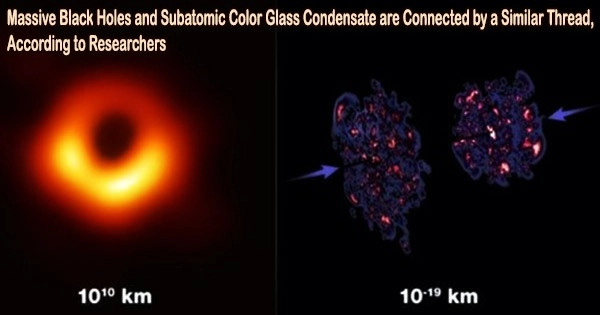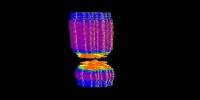Scientists have found an amazing correlation between the dense states of gluons, the cosmic equivalent of gluelike carriers of the strong nuclear force, and huge black holes.
Atomic nuclei colliding produce color glass condensates (CGCs), which are the dense walls of gluons. Less than a billionth of a kilometer across, this CGC is just 10–19 kilometers across. Black holes, in contrast, span billions of kilometers across.
The study, published in Physical Review D, shows that both systems are made of densely packed, self-interacting force carrier particles. In CGC, those particles are gluons. In black holes, those particles are gravitons. For the energy and size of each system, gravitons in black holes and gluons in CGC are arranged in the most effective way.
Black holes and CGC have a high degree of order because each system stores as much quantum “information” about the properties of the particles as it can. This includes information about their spatial distributions, speeds, and combined forces. Such limits on “information” content are universal.
Accordingly, the finding raises the possibility that quantum information theory might offer fresh organizing principles for comprehending these vastly dissimilar systems. Because of the mathematical similarity between both systems, learning about one can help us comprehend the other.
Comparisons between the gravitational shockwaves produced by black hole mergers and the gluon shockwaves produced by nuclear collisions are particularly fascinating.
Scientists study the strong force in nuclear collisions. For example, at the Relativistic Heavy Ion Collider, a Department of Energy user facility, atomic nuclei accelerated close to the speed of light becomes dense walls of gluons known as color glass condensate (CGC). The primary constituents of all observable matter, quarks and gluons, are created when the nuclei clash, and CGC develops to create an almost perfect liquid of these particles.
Though the strong force operates at subatomic scales, this recent analysis by scientists at Ludwig Maximilian University of Munich, the Max Planck Institute for Physics, and Brookhaven National Laboratory shows that CGC shares features with black holes, enormous conglomerates of gravitons that exert gravitational force across the universe.
A universal limit on the amount of entropy, or disorder, that can exist in each system appears to be satisfied by both sets of self-interacting particles. This mathematical relationship suggests analogies between the development, thermalization, and decay of black holes and the nuclear collisions that occur when walls of gluons hit at ultrarelativistic speeds close to the speed of light.
A crucial aspect of quantum information science (QIS), the limit on entropy that motivates this correspondence is connected to maximal information packing.
Thus, QIS may contribute to the knowledge of gluons, gravitons, CGC, and black holes by scientists. This strategy might also improve the development of quantum computers, which mimic and answer questions about these intricate systems using cold atoms.
















